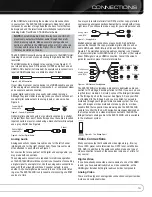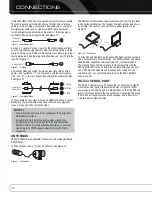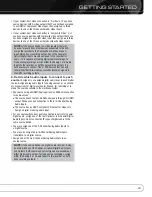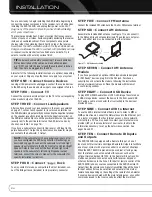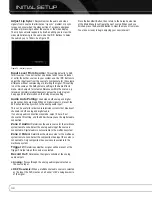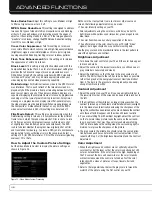
32
INITIAL SETUP
Adjust Lip Sync:
Resynchronizes the audio and video
signals from a source to eliminate a “lip sync” problem. Lip sync
issues can occur when the video portion of a signal undergoes
additional processing in either the source or the video display.
The Lip Sync adjuster appears by itself, enabling you to view the
video while listening to the audio. Use the
7
/
3
Buttons to delay
the audio by up to 180ms. See Figure 23.
Figure 23 – Adjust Lip Sync
Input Level From Source:
This setting defaults to 0dB
for all sources. If you notice that one device tends to sound louder
or softer than other sources in your system, use the
7
/
3
Buttons to
adjust the input level from the source to compensate for the volume
difference without compressing or distorting the signal. This setting
is not the same as the Dolby Volume setting in the Audio Effects
menu, which adjusts for volume differences within the source, e.g.,
television commercial advertisements versus the main program.
See page 33 for information on the Dolby Volume setting.
Audio Auto Polling:
Used when both analog and digital
audio connections are made. When no digital signal is present, the
AVR will automatically switch to the analog audio input.
This can be useful for older cable television systems that broadcast
channels in both analog and digital audio.
If an analog audio connection was made, select it here. If not,
choose the Off setting, and the AVR will always use the digital audio
connection.
Zone 2 Audio:
Determines the audio source for the multizone
system remote zone. Select the analog audio input the source is
connected to. Digital audio is not available to the multizone system.
Zone 2 Video:
Determines the video source for the multizone
system remote zone. Select the composite video input the source is
connected to. Only composite video sources are available to the
multizone system.
Trigger 2:
Determines whether a signal will be present at the
Trigger 2 Output when this source is selected.
Record Out:
Determines the signal available at the analog
audio outputs.
• Analog:
Passes through the analog audio signal selected as
the source input.
• DSP Downmix:
When a multichannel audio source is selected
as the input, the AVR creates a 2-channel “LtRt” analog downmix
of the signal.
Press the Back/Exit Button, then return to the Setup Source line
of the Main Menu to configure the next source. When you have
finished, press the Back/Exit Button to clear the menus from view.
You are now ready to begin enjoying your new receiver!
AVR 7550HD OM.qxd 2/25/09 11:52 AM Page 32


